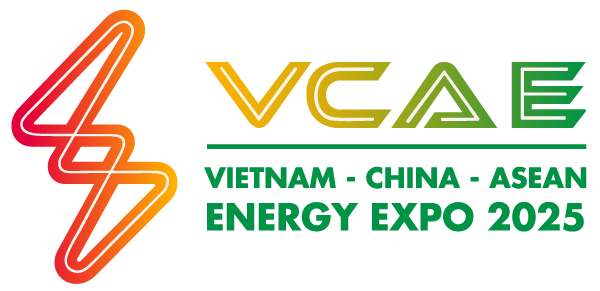– At the International Convention Center (35 Hung Vuong, Hanoi), the Committee on Science, Technology and Environment of the National Assembly and the Science Council of Vietnam Energy Review have successfully organized the 3rd Vietnam Clean Energy Forum with the theme: “Development of gas and wind power infrastructure in Vietnam”. The organizing committee summarizes the main contents of the Forum below for readers’ reference.

Mr. Nguyen Thai Son – Permanent member of the Scientific Council of Vietnam Energy Review announced the reason and introduced delegates to the Vietnam Clean Energy Forum (the third time).
This forum aims to share development opportunities, outstanding issues, appropriate advanced technologies, and highlight the solutions to solve problems and inadequacies to continue developing gas and wind power projects in Vietnam in the near future.

Chairman of the Vietnam Clean Energy Forum (the third time).
In the opening remark, Mr. Ta Dinh Thi – Deputy Chairman of the Committee on Science, Technology and Environment of the National Assembly raised the issue of climate change and Vietnam’s commitments in climate change mitigation at COP26. To develop the marine economy in line with the Party and State’s orientation, it is necessary to develop gas and wind power in Vietnam as an indispensable need to develop energy projects to meet the rapidly increasing demand for electricity, while ensuring energy transition in the direction of reducing greenhouse gas emissions, towards net zero emissions.

Mr. Ta Dinh Thi – Vice Chairman of the Committee on Science, Technology and Environment of the National Assembly.
Describing the situation of electricity development in Vietnam, Mr. Hoang Tien Dung – Director of the Electricity and Renewable Energy Authority (EREA, Ministry of Industry and Trade – MOIT) said: The power plants of Vietnam in 2020 increased by nearly 2 times in comparison with 2015, ranked 2nd place among ASEAN countries and 23rd place in the world. By the end of 2022, the total power capacity of the whole system reached about 77,800 MW, and sale electricity reached 242.3 billion kWh. The renewable energy (wind and solar power projects) strongly developed, gradually contributing to the reduction of greenhouse emissions and increasing the initiative in electricity supply.
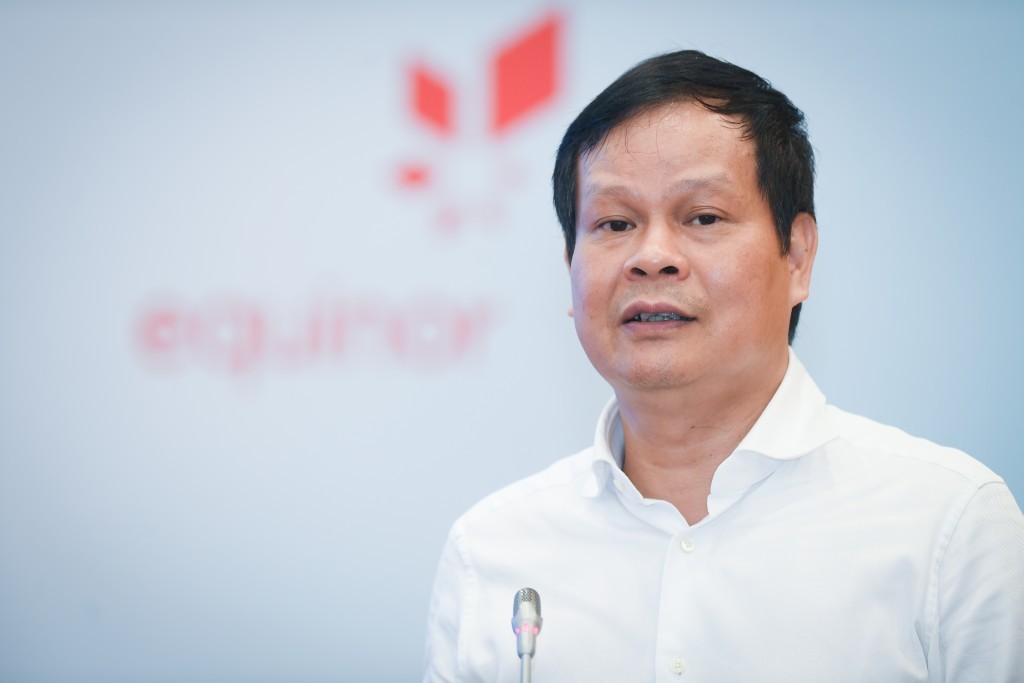
Mr. Hoang Tien Dung – Director of the Electricity and Renewable Energy Authority (Ministry of Industry and Trade).
The shortcomings in electricity development were pointed out by the EREA such as: the imbalance of the power supply and demand put pressure on the transmission grid, the large power plants were delayed for a long time, causing a shortage of power plants that running in base-load for the power system.
The coal thermal power plants were still occupied for a large proportion; electricity prices were not attractive enough to attract investment as well as promote electricity saving. Therefore, it is necessary to take measures to attract and encourage the private sector to participate in investment and development of power projects.
The Representative of Electricity of Vietnam (EVN) put an orientation to implement Resolution No. 55 of the Politburo on Vietnam’s national energy development strategy to 2030 and vision to 2050 and commitment of net zero emissions by 2050. These orientations are the way forward for Power Development Planning VIII (PDP VIII). A number of principles have been set for the development of power plants, as an input to PDP, which are: No new coal-fired thermal power after 2030, No new LNG power plants after 2035, promote the development of renewable energy plants. The wind and gas power projects have been reasonably structured and planned in the draft PDP VIII, EVN commits strictly to implement the power development program to 2030.
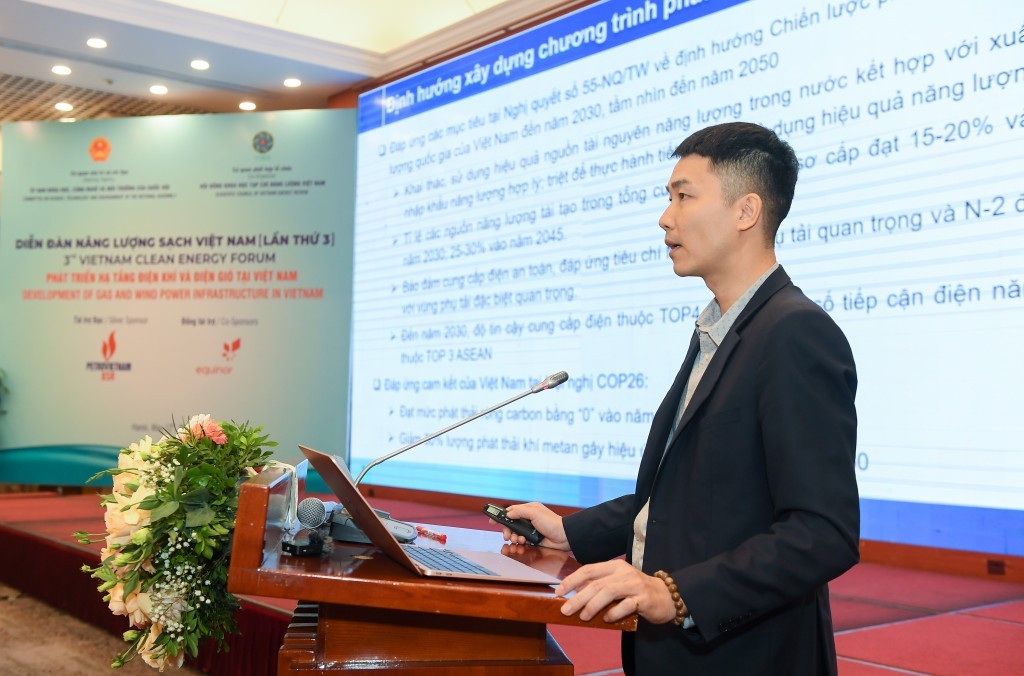
Mr. Cap Tuan Anh – Deputy Head of Strategy Department (Electricity of Vietnam).
Mr. Nguyen Anh Tuan in the Presidium of the Forum also said: EVN as a state-owned enterprise, can only buy electricity at a reasonable price while investors demand high prices. Therefore, it is necessary to have clear legal provisions to meet the principle of harmonizing benefits and sharing risks of parties involved in power purchase agreements.
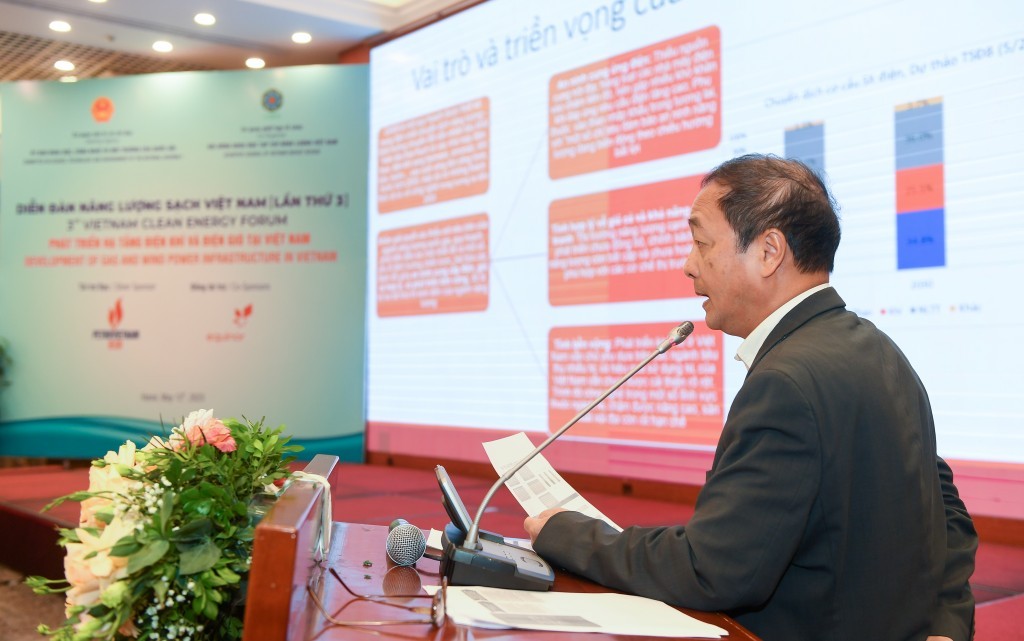
Mr. Nguyen Anh Tuan – Permanent member of the Scientific Council of Vietnam Energy Review.
Mr. Nguyen Anh Tuan – Permanent member of the Council Science of Vietnam Energy Review contributed a speech emphasizing that energy transition and environmental protection are the inevitable path for Vietnam.
The draft PDP VIII is a master plan designed for energy transition. Energy transition in Vietnam has taken place in the recent 5 years, going through the narrow path of the impossible trinity as the energy security, reasonable prices, and sustainable development. Vietnam is facing the problem of energy transition and electricity supply security at the same time. Power generation increasingly depends on imported primary energy sources increasingly. The competitive electric energy market has developed out of synchronously, leading to prices not following the market mechanism. But at the same time, there are opportunities such as the JETP (Just Energy Transition Partnership) agreement with a committed credit of $15.5 billion for equitable energy transition.
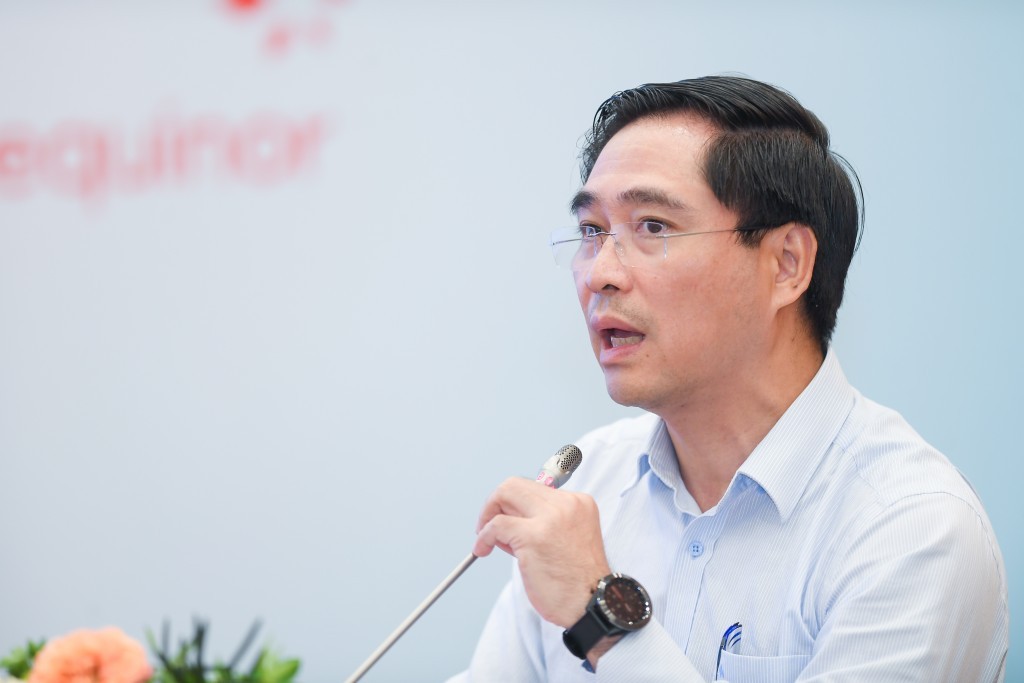
Mr. Pham Quang Huy – Deputy Director of Electricity Regulatory Authority (Ministry of Industry and Trade).
Mr. Pham Quang Huy – Deputy Director of the Electricity Regulatory Authority (MOIT) informed that, at present, the negotiation of power purchase agreement (PPA) for gas-fired power plants is still difficult because the plants want the committed rate of contract power output of 60% or more to be able to afford loans for project implementation and sign long-term gas purchase contracts. But EVN only negotiates the contracted power output according to the actual demand and the electricity price of the plant in the electricity market. LNG is a new type of power generation, so regulations are being developed.
For wind power, the FIT mechanism is a supporting electricity price mechanism, designed to promote investment in solar and wind power projects and is regulated for a certain period. Therefore, after the FIT mechanism expires, the wind power projects will comply with current regulations.
The MOIT has now set up a team to draft a Circular stipulating the method of building a price framework for the power generation, as well as a circular amending Circular No. 57/2020/TT-BCT.
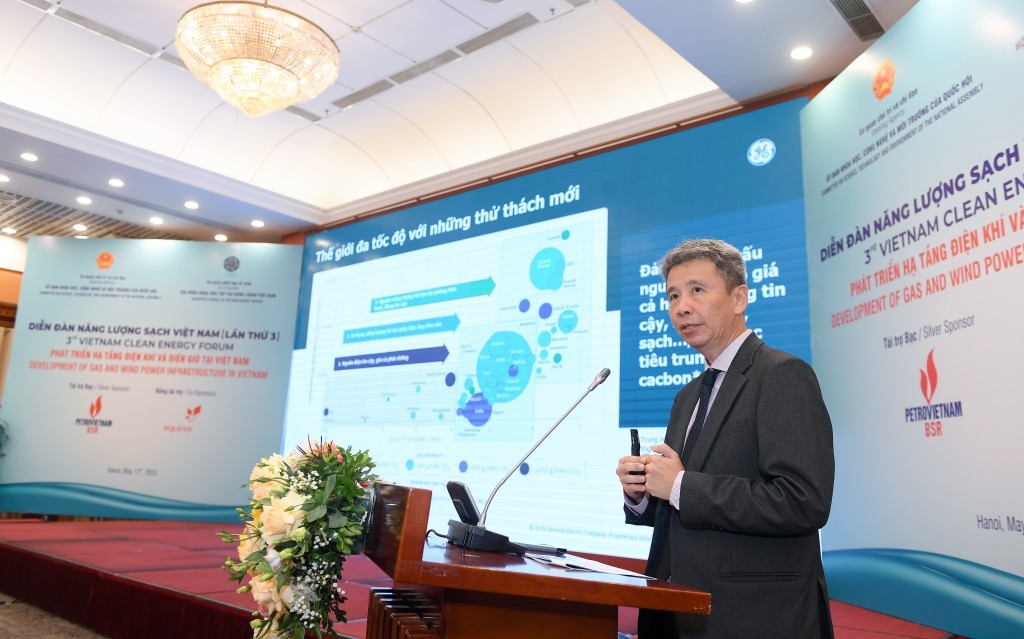
Mr. Wei Nan Yew – Sales Manager, GE Gas Power, Asia Pacific Region.
The GE Vernova understands the difference in energy transmission between developed countries (OECDs) and developing countries. That is, electricity consumption in developing countries will still increase, although it has surpassed consumption in OECD countries over the past decade. The developing countries can achieve greenhouse reductions by combining gas power and power from renewable energy. Selecting a reasonable structure of diverse power sources is always a measure to have flexibility and security in power supply. GE provides a wide range of solutions from gas turbines, steam turbines, hydro turbines, onshore and offshore wind turbines, grid solutions… to meet all the needs of growth in power generation and energy transition of a developing country like Vietnam.
From the investor in LNG power plants, the representative of PetroVietnam Power Corporation (PV Power) presented the difficulties in developing a LNG power plant in Vietnam.
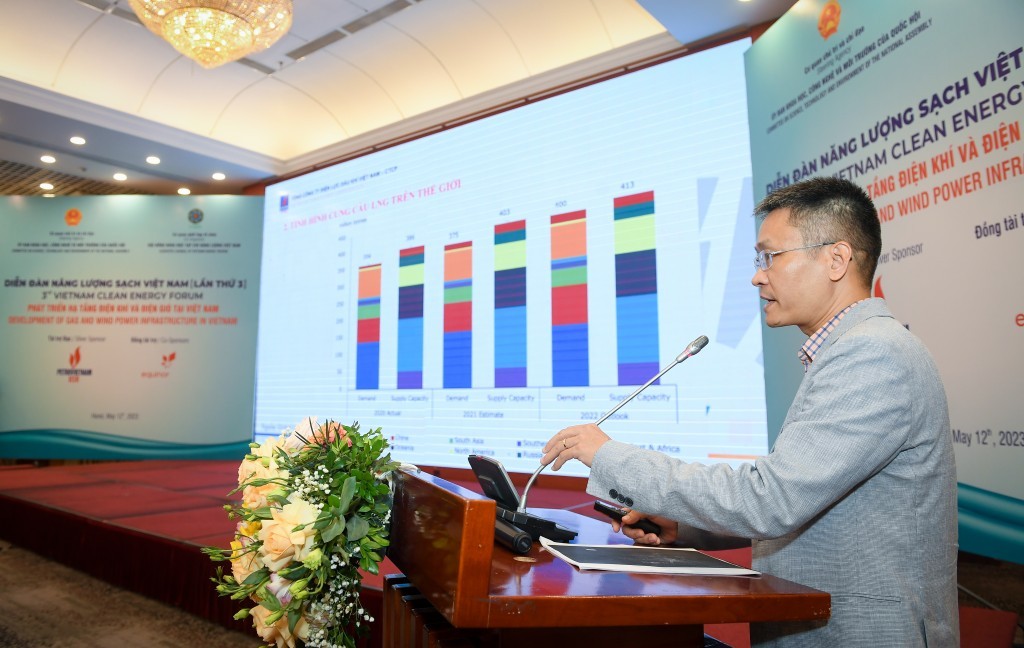
Mr. Vu Van Loi, Head of Investment – Construction Department (PetroVietnam Power Corporation).
The LNG power plant has the role of ensuring the base power supply to replace coal power plants, and at the same time supporting the stable and reliable operation of the power system with the increasing proportion of renewable energy. After the crisis, LNG prices will return to normal levels and be competitive with other fuels. LNG turbines will be ready to burn with hydrogen if hydrogen prices become competitive. However, investment and development of LNG power plants face many difficulties. The first is the long-term land clearance and handover. After that, there is a problem with the appraisal of fire prevention and fighting design, which must be qualified for technical design appraisal.
But for fire prevention and fighting appraisal, the documents must be equivalent to the stage of construction drawing design. On the other hand, so far, there is no electricity generation price framework for LNG power plants. PPA negotiations have been 2 years and still not finished. QC cannot negotiate. The time to determine the volume of LNG in the international market is in August while the output of electricity generated next year is determined in December, making it difficult to negotiate to buy LNG at a reasonable price. There is no mechanism to encourage LNG electricity to contribute to grid stability.
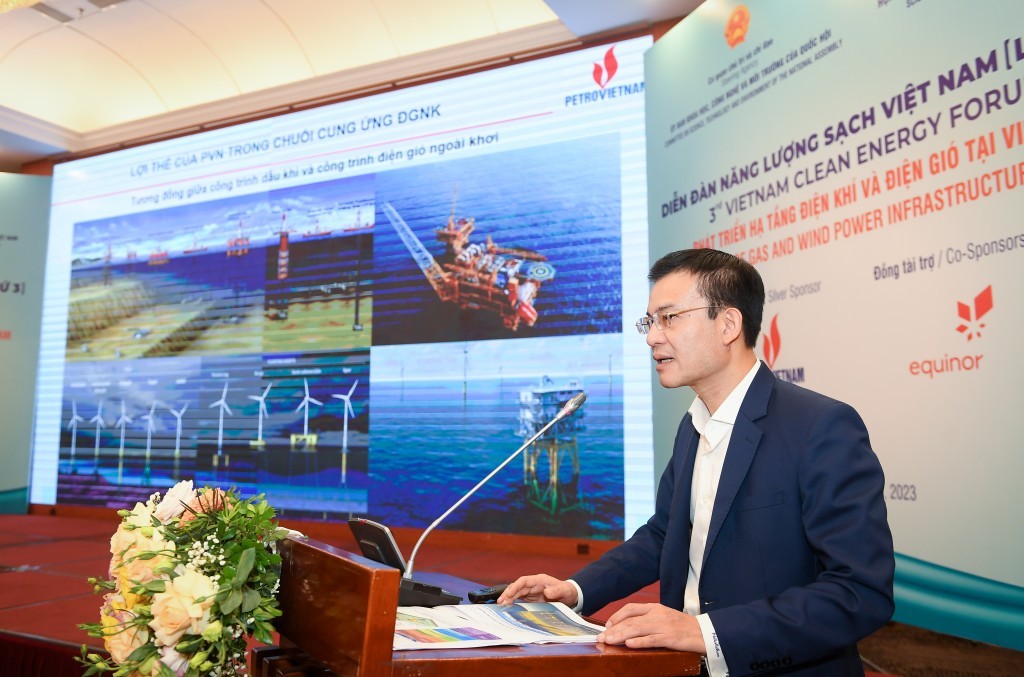
Mr. Nguyen Quoc Hung – Deputy Head of Electricity and Renewable Energy Department (PetroVietnam).
According to Mr. Nguyen Quoc Hung – Deputy Head of Power and Renewable Energy Department (PetroVietnam- PVN): PVN has obvious advantages in participating in the wind power supply chain. The oil and gas companies around the world have grasped the quick trend of energy transition. Experience in implementing offshore oil and gas projects, synergies with offshore wind power projects will greatly contribute to the developers of the offshore wind power projects. The big names in the offshore wind power projects are from oil and gas corporations in the world. PVN has signed a memorandum of understanding with a few companies to study the development opportunities for the offshore power projects. With a system of infrastructure such as ports, warehouses, transportation/lifting/construction equipment, PVN and its member units are always trusted by customers to choose and assign EPC/EPCI for offshore and onshore projects. PVN currently owns construction and manufacturing bases for oil and gas projects in Vung Tau, Quang Ngai and Thanh Hoa with modern equipment. PVN members have a fleet of nearly 100 service ships, diverse in capacity and types such as 1200/600-ton crane ships, tugboats, transport barges, DP dynamic positioning ships… Along with the large financial resources, PVN can arrange capital for investment projects in new and renewable energy projects.
Currently, Vietsovpetro has won the bid and is carrying out geological and environmental survey work for Lagan offshore wind power project, PTSC signed a contract to measure wind, wave, and flow for Thang Long offshore wind project…
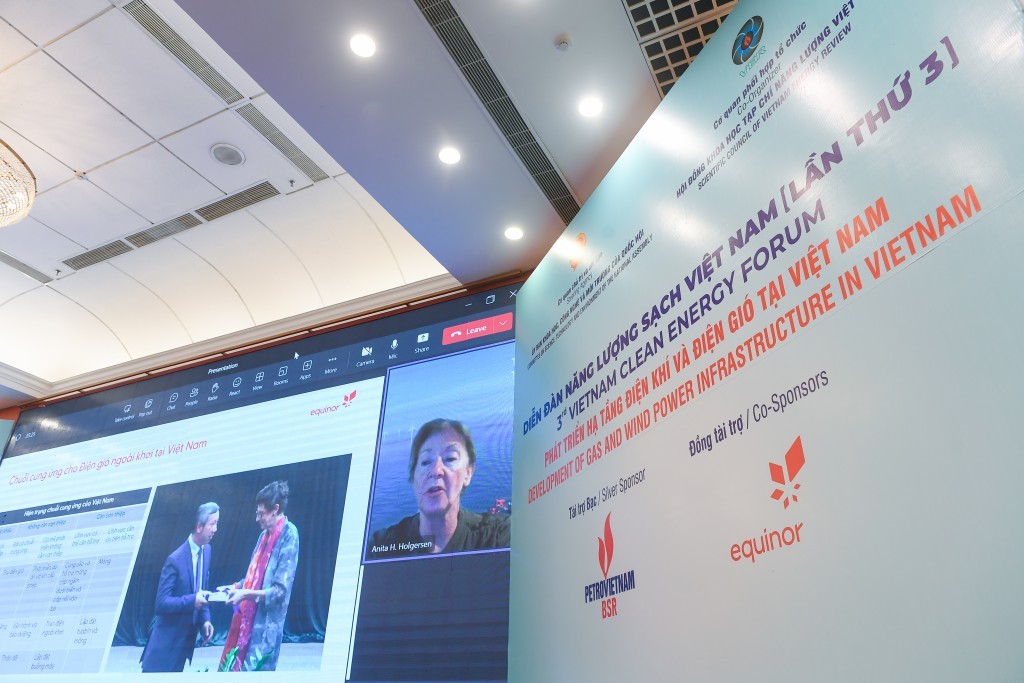
Ms. Anita H. Holgersen – Senior Market Development Manager and Chief Representative of Equinor in Vietnam.
Speaking online, Ms. Anita H. Holgersen – Senior Market Development Manager and Chief Representative of Equinor (Norway) in Vietnam said: Equinor is an oil and gas company, sharing experiences from projects all around the world. Equinor would like Vietnam to promote the development of offshore wind power. Vietnam has a large offshore wind power potential, close to load centers, as planned in the draft PDP VIII. The Vietnamese government has committed to net zero emissions by 2050.
participate in the offshore wind power supply chain in Vietnam. Beside turbines, generators, room of generators, and engine room covers, which must be imported, the rest such as power capacitors poles, foundation installation, connecting cables with the coat, power stations, and construction work can be done by Vietnamese companies. According to Ms. Anita H. Holgersen, If the PPA would be guaranteed, offshore wind power projects can access low-interest international capital sources.
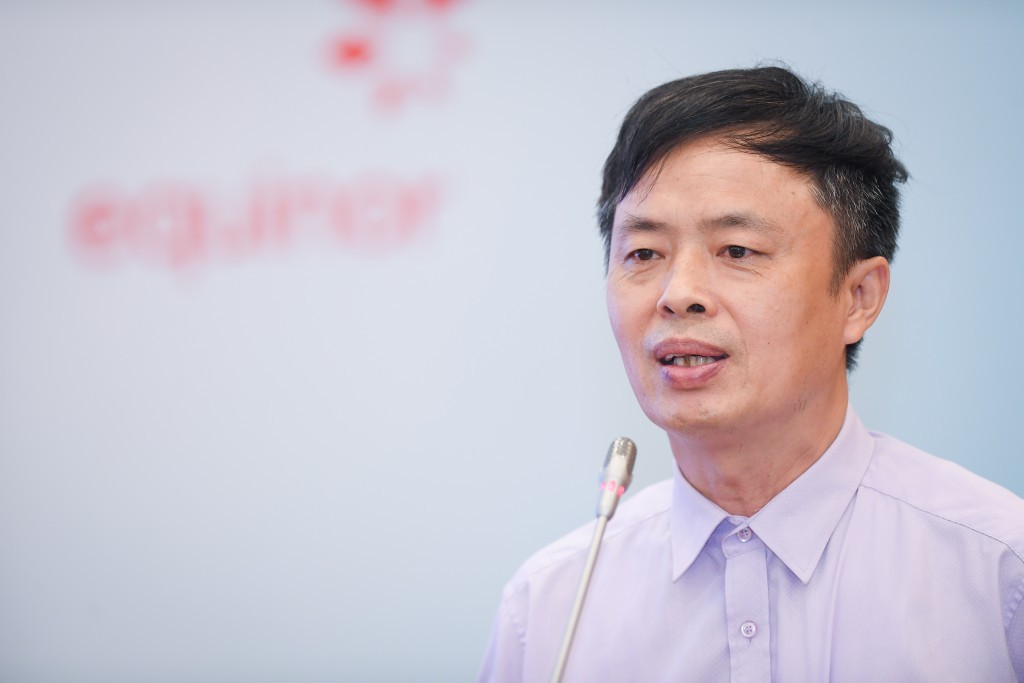
Dr. Du Van Toan – Head of Marine Science and Climate Change Department, Institute of Sea and Island Research (Ministry of Natural Resources and Environment).
Dr. Du Van Toan – Head of Marine Science and Climate Change Department, Institute of Sea and Island Research (Ministry of Natural Resources and Environment) presented a very optimistic picture for the future of wind power in Vietnam.
The number of registered projects in the country has an installed capacity of more than 162 GW. Vietnam needs to conduct research to assess the technical potential of offshore wind power at a national scale. International studies give different numbers. Vietnam’s research needs to be more specific and can be conducted by the Ministry of Natural Resources and Environment or MOIT. It is necessary to pay attention to the environmental impact of wind power projects. Wind turbines will take part of the kinetic energy of the moving air, reducing the speed of the wind. If the average wind speed is reduced, that moving air stream will be hotter in the summer and colder in the winter. The noise and vibration frequency in seawater during installation can affect the life of marine life, whales and dolphins. Rotating propellers can kill birds, but the rates are very low.
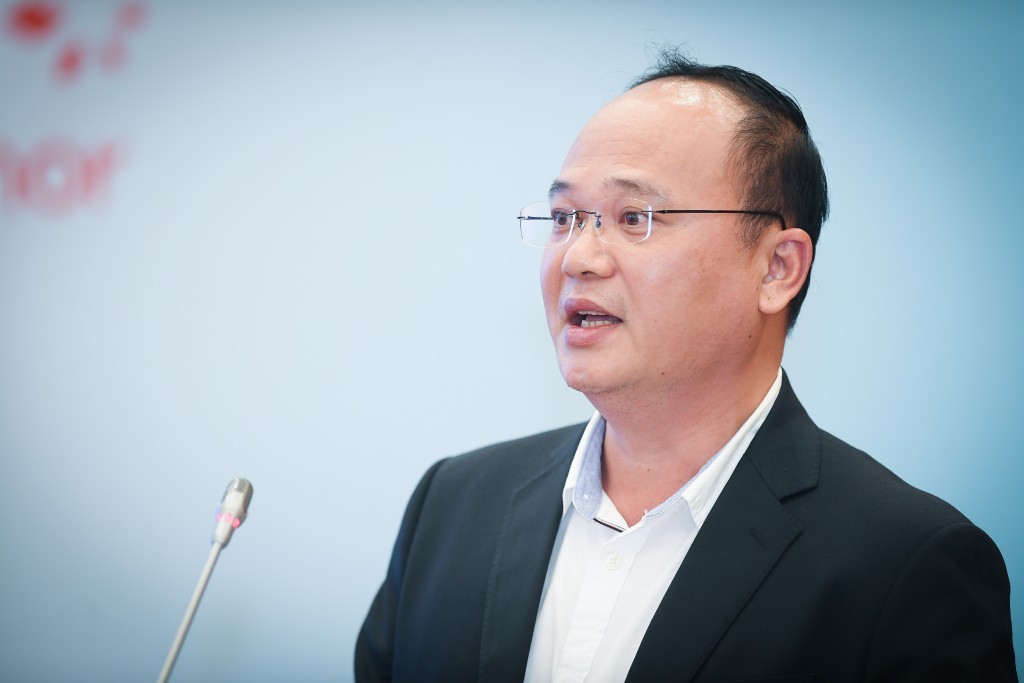
Mr. Nguyen Hai Phu – Deputy General Director of Power Construction Consulting Joint Stock Company 2.
In the field of consulting for development of renewable energy and electrification projects, Mr. Nguyen Hai Phu – Deputy General Director of Power Engineering Consulting Joint Stock Company 2 (PECC2) introduced his position in this new market. PECC2 undertakes survey, planning, design, construction supervision, EPC contract, mechanical equipment manufacturing, equipment maintenance and repair, power plant management… Offshore wind power is facing many problems, one of which is that there is no marine spatial planning.
Regarding gas power investment, PECC2 considers that an LNG power plant needs to have a large enough capacity to optimize costs and ensure economic and financial efficiency of the project. LNG import ports must accommodate LNG ships with a tonnage of over 150,000 m3.
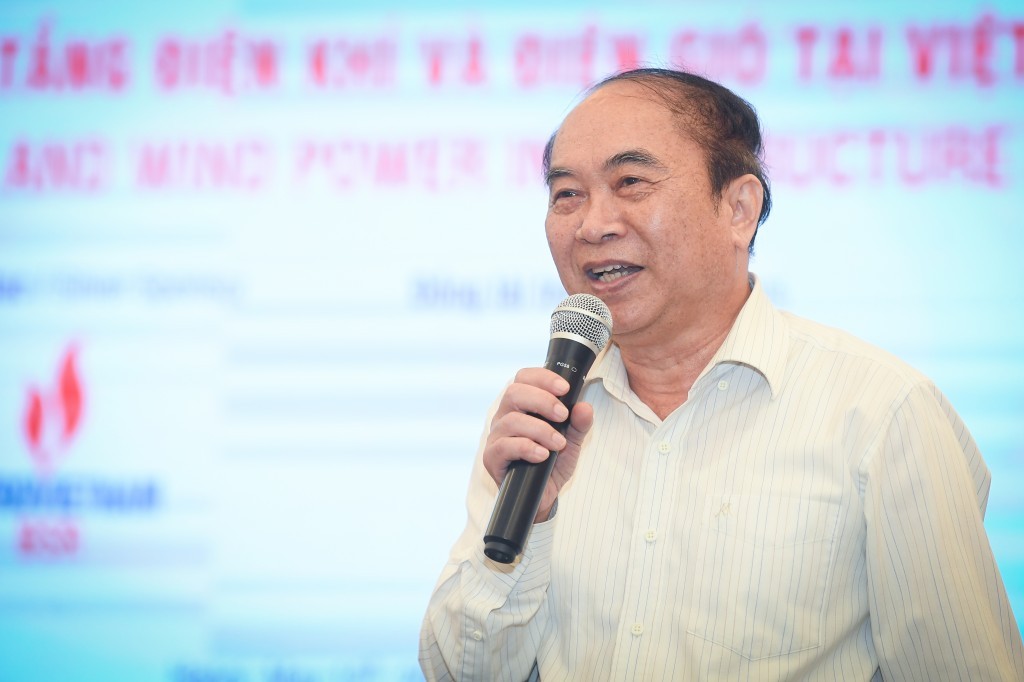
Delegates expressed their opinions.
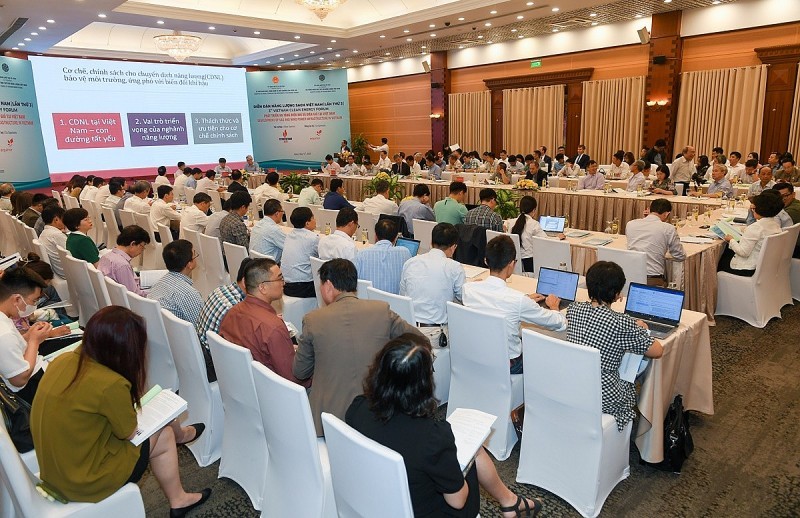
Over 200 delegates attended the Vietnam Clean Energy Forum (the third time).
Concluding and closing this Forum, Mr. Ta Dinh Thi – Deputy Chairman of the Committee for Science, Technology and Environment of the National Assembly affirmed: The discussions at the Forum raised problems about legal regulations and barriers and challenges in deploying and development of LNG and wind power infrastructure, that shows there are still many problems to be solved in the coming time. In addition to the delay of PDP VIII, which has stagnated many power projects.
Specifically, for LNG power projects:
1/ Lack of experience in negotiating and signing LNG imports.
2/ There is no framework for LNG electricity tariff, off-take ratio, and mechanism to convert gas price to electricity price.
3/ Lack of regulations and technical standards regulations on design, construction, transportation, operation, and maintenance of LNG import terminals and on safety in transportation, loading and unloading, and LNG fuel storage.
4/ LNG power plant includes many links in which the port and storage are very important, requiring strict technical requirements.
5/ Splitting the size of LNG power sites will reduce project efficiency.
For wind power:
1/ Lack of marine spatial planning for offshore wind power deployment.
2/ Lack of regulation for the licensing process in marine surveys for offshore wind power projects.
3/Lack of the mechanism for bidding to select investors.
4/Transportation of the equipment faces difficulties on traffic and roads.
5/ Difficult ground clearance.
6/ Many risks in implementing a transmission grid synchronous with the offshore wind power project.
7/The content of localization equipment is still low.
Discussions and exchanges in the Forum further analyzed opportunities and challenges in developing LNG and wind power projects, especially offshore wind power; proposed the Start policies and mechanisms and appropriate solutions. According to Mr. Ta Dinh Thi, it is also important step on “fuel coversion”. In PDP VIII, in the period from 2035 to 2050, there will be many power plants that need to burn mixing gas and hydrogen, moving towards completely using hydrogen fuel by 2050. Then the economic life of a few power plants is not over. On the other hand, hydrogen fuel technology, in even developed countries at this stage, are in trial experiment, not widely commercialized soon, and the cost is still high.
For wind power, especially offshore wind power, it is necessary to pay attention to the challenges that the area with good wind potential often locates far from the load centers, requires long power transmission lines, increasing project costs, and risking of being out of sync with the project development.
Solutions for solving also need to come from both sides: Both the State, as well as businesses. The enterprises also need to carefully study the project’s PDP, appropriate locations, favorable level for the transmission grid infrastructure, financial ability, capital loan sources and ability to mobilize the resources in terms of technology, equipment… to avoid arising risks.
In addition, the potential of offshore wind power is very large, so Vietnam needs to pay attention to building mechanisms and policies to attract investment to promote domestic production and equipment supply chain to serve offshore wind power projects and regional exports…
Mr. Ta Dinh Thi also confirmed that the presentations and discussions at the Forum are the scientific backgrounds for commenting on the report of the National Assembly’s Oversight Delegation with suggestions for adjusting policies and laws in the future for energy development in general, wind and gas power infrastructure in particular.
VietnamEnergy.vn
